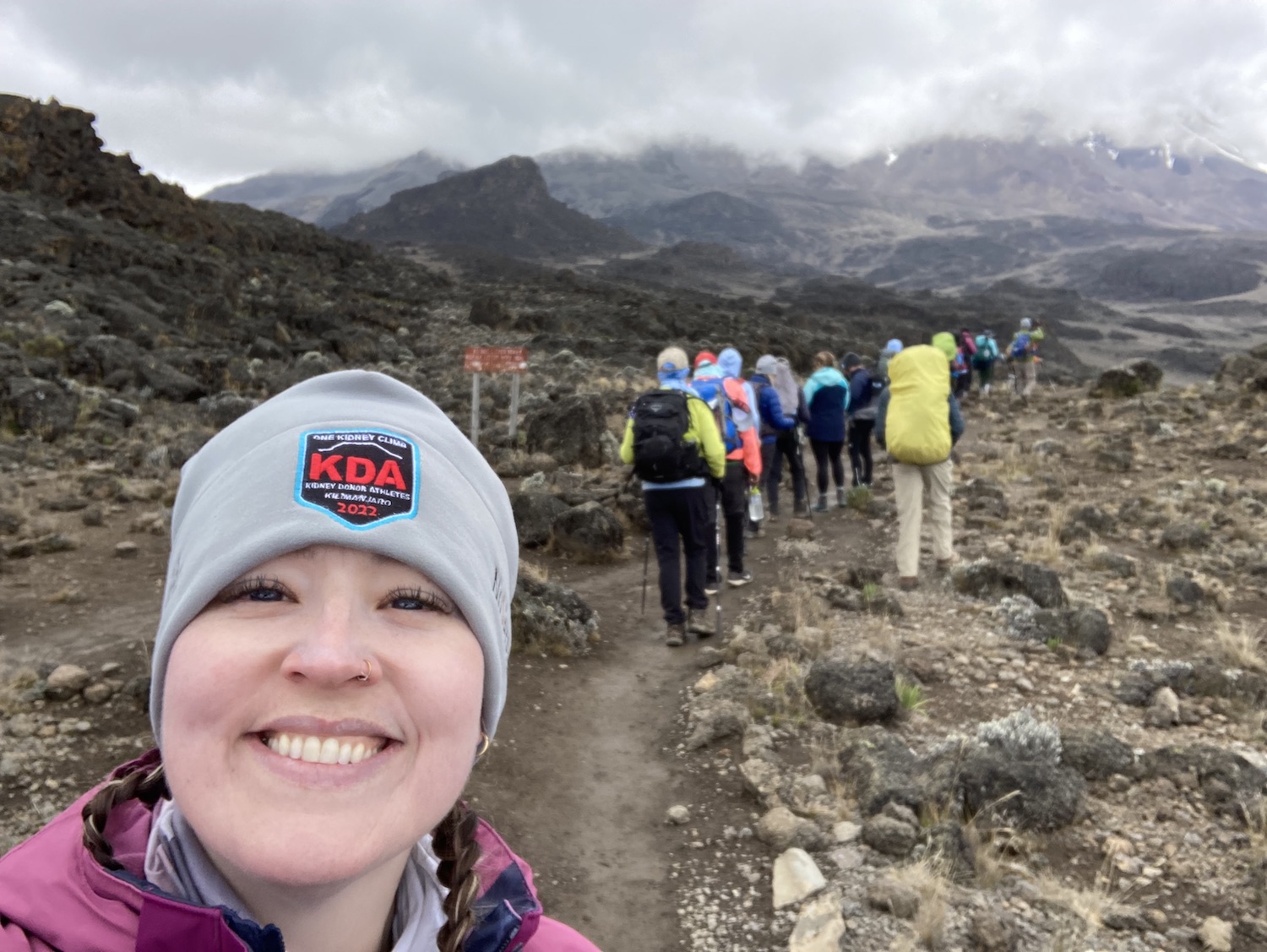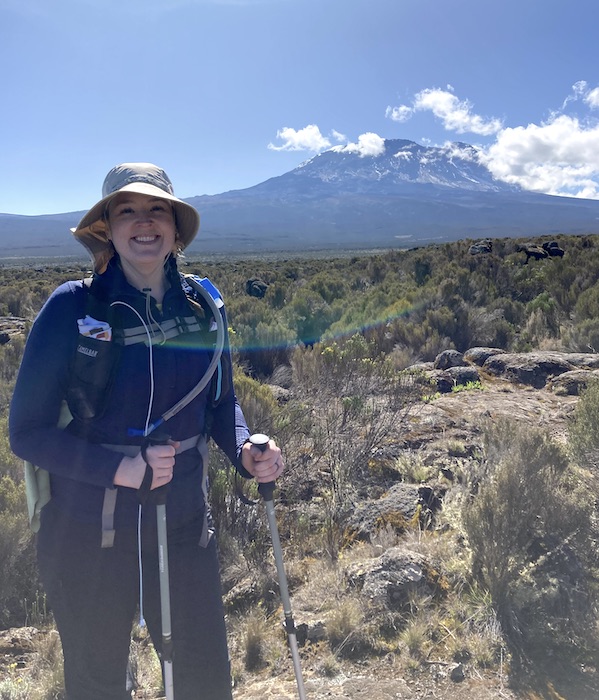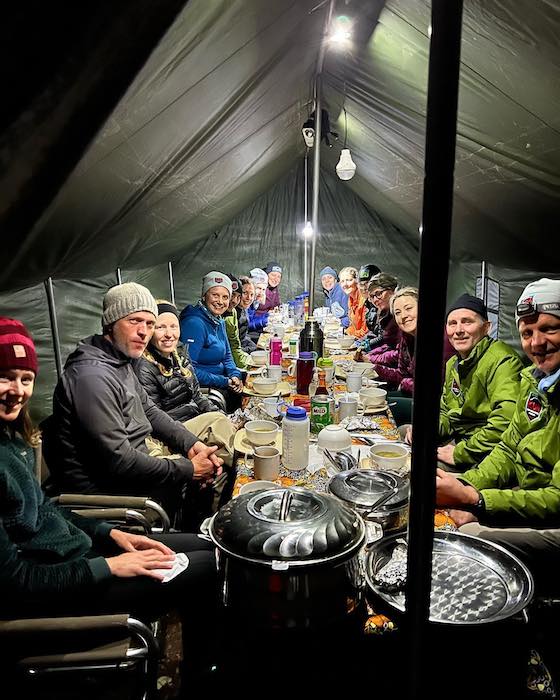SIS student takes living organ donation to new heights

School of Information Sciences student Emily Polet-Monterosso, who will graduate in spring 2022 with a master’s degree in library and information science, says that becoming a kidney donor is the best thing she’s ever done. It was such a positive experience, in fact, that she wanted to shout from a mountaintop that living donors can lead full, healthy, and active lives. And she set out to do just that. After donating a kidney in 2019 to a stranger in need, Emily, along with fellow members of the Kidney Donor Athletes (KDA) organization, climbed Africa’s Mount Kilimanjaro on World Kidney Day in 2022 to raise awareness for living donation.
An altruistic path
Following graduation, Emily plans to continue giving back. She wants to pursue a career as a librarian, where she hopes to work at a public library and help advise young people about how to access potentially life-changing information. Having worked at a private college before starting classes at Wayne State, Emily wants to use her skills to help the next generation of students. remedy disparities in financial and college readiness.
“Working with young people entering college, I saw how very real disparities in financial and college readiness were,” she said. “I believe that part of the remedy is access to information. Students may not always be able to ask a counselor, a teacher, or a parent – but they can always find the public library.”
A stranger becomes a friend
Emily remembers the exact moment in August 2018 when she became aware of a family’s plea for help in finding a kidney donor for their loved one. She was at Cedar Point amusement park waiting in line to board an extreme roller coaster. She scrolled through Facebook to pass the time and came across a post shared by her sister – a picture of a car with writing in the back windshield that said, “Single dad of 3 needs type O kidney.”
“I saw the post and I thought ‘I’m going to call.’ I know I’m a type O blood donor, the phone number had a local area code and I know that for a family to have to resort to this type of advertising, they must have felt desperate,” Emily said. “All of a sudden it was like a slot machine – things just seemed to line up and I can’t explain it, but it just felt like the right thing to do.”
After some initial concern from her husband and family, Emily moved forward with their full support as she began the testing process to see if she was indeed a match for Ryan Stanford, the local father whose condition was beginning to worsen as he held out hope for news of a donor.
“I was able to reassess at every step in the process,” Emily said. “I kept telling myself, ‘If I make it to the next step I’ll keep going and it’s meant to be.’” She got the call that she was a match on October 31, 2018, and the surgeries were scheduled for the following January. “It all went so smoothly and beautifully. The transplant center at Henry Ford was amazing. The doctors and nurses were consummate professionals and made me feel safe and supported every step of the way.”
The bond between donor and recipient is hard to put into words for those who have not experienced it. Emily attended Stanford’s wedding in 2021 and they continue to stay in touch despite Emily’s incredibly busy personal and professional schedules.
While earning her degree, Emily also works full-time as a recruiter for MetroEHS Pediatric Therapy and as a part-time children’s librarian at the Utica Public Library – all while training as a Spartan athlete and as a member and mentor for KDA.
An active donor
Although she is the first kidney donor to complete a Spartan Trifecta [Spartan Race is a leader in the sport of extreme obstacle racing. The trifecta is earned by completing three different Spartan races in one calendar year.], Emily wasn’t always fitness-minded and came to athleticism because of the kidney donation. She started getting into better physical shape to ensure a faster recovery after her surgery and she didn’t stop there. She got back to the gym two weeks after the surgery for light workouts and began intensive training just four weeks later.
It was during an early pandemic online Yahtzee tournament that Emily and fellow KDA members began hatching a plan that would become the “One Kidney Climb,” a summit of Africa’s highest peak to raise awareness of the need for living kidney donors for the more than 100,000 Americans currently on the donor waiting list. As word of the climb spread, 22 KDA members joined in the effort.
Before the KDA was founded in 2018 there were limited resources for those interested in becoming a kidney donor. “The KDA is incredible. It provides the opportunity to connect with people in all stages of the donor process to gain insight into what life will be like as a living donor,” Emily said. “It’s a unique thing within the donor community. It takes a certain type of person to donate, and I realized with every one of these people – we had a connection that was even closer than friends right away.”
That closeness only intensified as the group worked together and depended on each other as they spent more than a week working their way up – and then back down the mountain. KDA partnered with Embark Exploration Company to prepare for the eight-day journey. The guides provided the donor athletes with a 12-week training regimen that included modifications for climbers training in flat terrains prior to arriving in Tanzania.
According to the KDA’s Mount Kilimanjaro fact sheet, it is estimated that half of the climbers who attempt to reach the mountain’s peak each year fail to do so, mostly due to altitude sickness. The summit is 19,341 feet above sea level and the ascent is much like going from the equator to Antarctica in a single trip as climbers encounter five ecological zones along the route, becoming increasingly colder until reaching the summit which is in the arctic zone.

Unfortunately, Emily was one of two KDA members (and one of the estimated 15,000 climbers annually) who were not able to reach the summit. She began experiencing altitude sickness several days into the climb and was unable to eat. Emily continued to push forward, but as the team reached the basecamp just before the final push to summit, she began experiencing respiratory issues and the guides would not allow her to continue.
Although it was heartbreaking to make it so close and come just shy of the summit, Emily says that it was a fractional moment that took nothing away from her amazing experience. “I feel exceedingly proud of my effort and of what I accomplished, and I couldn’t have done it in better company,” she said. “My fellow kidney donors truly are the salt of the Earth. I heard nothing out of anyone’s mouth but encouragement and positivity.”
Emily was able to remain at basecamp and complete the descent with the rest of the KDA team. The two-day descent was more physically demanding than the six-day climb. The descent equates to a nearly 20,000-foot vertical drop – two times the amount that you would descend if you were to go down the Grand Canyon.
After the climb
While earning a degree usually comes with academic challenges, not every student donates an organ and climbs a mountain along the way. Emily acknowledges that she “could not have done any of it without the support of my husband.”
She said that the flexibility of her professors, especially those in her final semester, helped her stay on track academically while navigating her donation journey. She cites professor D. Walster and peers Jaime Yocum and Sarah Winkels, whom she’ll meet in-person for the first time at graduation, as sources of support.
Although Emily is unsure if she will attempt to climb another mountain, one thing is certain: the bonds, relationships and memories she created with her fellow climbers will last a lifetime.
“I don’t shy away from risky experiences so it’s not outside the realm of possibility to do another extreme climb,” she said. “But mountaintop experiences aren’t just reserved for mountains.”
[Tom Racek, founder and president of Summit Pointe Productions, joined the KDA to capture the One Kidney Climb experience. See the video here.]